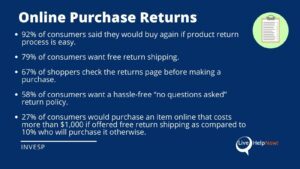5 Ways to Build Personal Connections with Customers Virtually
05 Aug 2021 By: Natalya Bucuy
Updated
What matters most to online shoppers?
According to a recent study by Google, it’s the lowest price and free shipping. This is where giant conglomerates like Wal-Mart and Amazon have everyone beat. So, does that mean smaller companies have little chance of winning customers?
No, it does not. And here is why.
While customers who do business online value price and shipping over other things, there’s something else that drives customer loyalty, repeat business, and positive reviews. And that is personalization of customer experience.
By offering a personalized customer experience, you increase the number of consumers and clients that will trust you with their purchases. How can you better personalize your customer experience? #CRMStats #Stats #CRM #Personalization #Automation #AI pic.twitter.com/nRje4rNEGY
— GreenRope (@GreenRope) June 18, 2021
Customers love personalization. According to Invesp, an expert company in the eCommerce space, customer statistics paint a clear picture.

So yes, personalization helps build strong customer relationships. But how can a company create strong personal bonds in a virtual setting? After all, they only get to interact with their customers through a screen.
That is tricky, but don’t worry. We got you covered! Here are five ways to build personal connections with customers virtually.
1. Magic Words Do the Trick.
Remember, when we were little, our parents taught us the magic words of “please” and “thank you.”? Well, in the business world these magic words of gratitude can go a long way. Especially when companies put efforts into thanking their customers for their business in thoughtful ways. Let’s look at some successful examples.
Show, Don’t Just Tell: Create Video Messages
Visual messaging has become a constant in modern communications. So it only makes sense to use it in customer communications. First of all, people are more likely – about 300% more likely! – to open and review an email that contains video as opposed to one that does not. (WordSteam). And secondly, a personalized video message is a great way to thank customers for their business.
Chris Laan of Designer Sheds elaborates:
“You obviously can’t [send a video to everyone. So save it for the customers who’ve made a big purchase, and personalize the video without going overboard. Shoot a video where you thank them for the purchase while you stand beside a similar version of the same product. Give them a few quick tips and show them how they work in a ‘live’ demonstration. It’s okay to use the customer’s name, but don’t go too far beyond that on the personal details. It’s a great way to go the extra mile without spending anything but a bit of your time. (Chris Laan, Designer Sheds)
Here is an example of a casual thank you video from Jacquez Art and Jersey Framing.
Write It Out: Send Thank You Notes
Here is another good old-fashioned way to say thank you – personalized thank you notes. In the digital world, a handwritten note is a rarity. In fact, according to the U.S. Postal Regulatory Commission, the average American received only 10 pieces of personal mail for the year in 2017. So there is a great chance that a personal note will stand out and will help build personal connections with customers. Experts agree.
Datis Mohsenipour, Director of Marketing at Outback Team Building & Training recommends adding such personal touch to communications with customers. “Kick it old school, and send your customers personalized cards,” he says. “In today’s virtual world, this small gesture can go a long way. In fact, I recently ran a poll on LinkedIn where 79% of folks said they’d rather receive a hand-written card instead of a phone call.”
Send a thank-you note. When was the last time you sent or received a thank you note? Surprise and delight your customers by sending them an old-fashioned, handwritten note in an envelope with an address and a stamp.
— Shep Hyken (@Hyken) August 4, 2021
Here is a great example of a business owner seeing great results from this practice.
“I’ve had multiple customers reach out to me to thank me for the note I’ve written. There’s something people really enjoy about this extra effort and the touch of sincerity it brings. It’s something that only takes a few minutes, but might help to secure a customer for life.” (Kate MacDonnell – CMO of Coffee Affection)
Flattery Will Get You Far: Give Compliments.
This one is a bit unusual, but definitely makes sense. We all like compliments. As the old proverb goes, “Kind words are like honey–sweet to the soul and healthy for the body.” So it’s no surprise that saying something nice and personal can help build personal connections with customers. Here is an example.
“Online business can feel so automated these days, but I’ve found that people still like to feel like they’re doing business with a real person and not just a screen. Because our business model involves our customers sending us photos for their passports, we always make sure to compliment their smile or some facet of the photo. It’s a small thing, but people really enjoy it.” (Tomasz Mlodzki,CEO of photoAiD)
We don’t all get to see our customers’ photos, but if there is an opportunity to compliment a customer, do take it. It could be as simple as their product choice or the uniqueness of their names.
2. You Can’t Pour From an Empty Cup.
As this saying implies, we can’t give what we don’t have. Team members who don’t feel valued or don’t have the right tools to serve customers cannot deliver good customer service. They cannot build personal connections with customers if they themselves don’t feel connected to the brand and its mission.
Taking care of your employees will ensure a positive company culture and environment. After all, like everything else in life, improvement and satisfaction starts from within.
“People are perceptive, and if your employees feel disenfranchised, burned out, or unmotivated with their work, your customer is going to sense it,” says Head of Marketing at Kintell, Mark Hayes.
The solution is to create a positive employee culture, one that motivates, engages and supports all team members. Companies can do so by empowering employees. Ask their opinions, express gratitude for their work, and set clear direction and goals. Allowing flexibility, welcoming creativity, and setting challenges through daily tasks can also create a sense of value for employees.
Heyes also suggests to start cultivating empowering employee culture from the very beginning.
“Be attuned to the people you employ, and ensure that they are genuinely passionate about delivering a quality service. This is going to boost eCommerce customer satisfaction a lot more than any gimmick, trick or new promotion,” he says.
If employees feel well-cared for, they will pass on that energy to the customers. They will work harder to serve the customers as best they can, and customers will feel that kind of attitude even through their screens. If your teams are working remotely also ensure clear and effective communications. Jessica Robinson of The Speaking Polymath offers a list of Five Golden Rules For Effective Team Communications Among Remote Teams.
3. Loyalty is Royalty.
When customers come back for more business it’s essential to show them that they have made the right choice. Of course, products, services, and customer service still have to be of highest quality. But as a special thank you, it’s important to reward returning customers. Treat loyalty like royalty.
Devin Schumacher, the Founder of SERP recommends introducing a loyalty program to build personal connections with customers and boost their satisfaction.
“It’s common for consumers to pursue services that offer a sense of “progression.” Loyalty programs are a great way to keep your consumer invested. This is because each purchase they make is ‘remembered’ in the points that they earn,” Schumacher says. “That means that consumers are a lot less likely to suffer from buyer’s remorse because they have a tangible quantitative incentive for buying from your company, as well as the product or service itself.”
Real business examples prove this point of view true.
“Interestingly, we found that 30% of our repeat customer purchases are directly attributed to our loyalty rewards program. This is likely due to the nature of our eCommerce store: Editor’s Pick sells anti-aging and skincare products. People’s lifestyle keeps them shopping.
Remember that loyalty rewards programs incentivize and accelerate an action that customers are already intending to do. The only difference is that they carry out that recurrent action with you and your company specifically. Overall, this solidifies customer advocacy of our store and builds positive brand connotations. It’s a way to pay people back for their repeat custom. (Kathryn McDavid , CEO of Editor’s Pick)
4. Random Acts of Kindness Are Not Just For Strangers
We’re always called upon to spread the spirit of kindness in the world. Well, there is no better place to do it than in business. Show customers you appreciate their business in unique, creative ways. It can only help build personal connections with customers, especially in the limited space for personalization in the virtual world. So think of what you can do for each customer that shows care beyond mere purchase. Explore how you can add unexpected value to customers’ businesses.
A great example of a company going above and beyond for their customers is the famous online pet supplies retailer, Chewy. First of all, the company wins customers from large conglomerates like Amazon with its outstanding customer service and tireless devotion to their customers. Beyond that, however, Chewy makes a point to add personal touches to their customer’s transactions. For example, the company delights its customers with custom pet portraits and kind personal notes.
Oh my god, @Chewy thank you so much for surprising us with this Noble Blood-themed portrait of Beetlejuice! (As if he needed another excuse to act like the prince he is) pic.twitter.com/AX6j2iOYTE
— Dana Schwartz (@DanaSchwartzzz) October 29, 2020
Adorable, isn’t it? This kind of personalization can do absolute wonders to customer retention. After all, customers now have a personal connection to the company.
5. Take Back What is Not Wanted
Noone wants to hold onto something unwanted. Customers included. That is why it’s essential to implement an easy return policy. Here are some insightful statistics:

Travis Turner, Director of Business Development at Hire Dynamics urges companies to take a close look at their return policies.
“The returns process is, perhaps, the biggest pain point for customers,” he says.”Typically, the easier it is for them, the better the experience.”
Here are some ways Turner recommends to enhance the return process:
- Include a return shipping label, allowing the customers to schedule USPS pickups at their home.
- Partner with a brick-and-mortar retailer to allow in-store returns. (Think Amazon and Kohl’s partnership)
- Eliminate the need to return the item at all. Send a full refund or replace the product.
Communicating with customers through the return process might also lead to some unique opportunities. For example, if a customer returns an item, it might be a good time to recommend a different product that might be a better fit. Try reaching out to the customer via email or allow them to process returns via live chat communications. Both options will give you access to direct conversation with the customer. This will not only show that you care about the customers’ complete satisfaction, but will help build personal connections with customers.
Build Personal Connections with Customers
Let’s face it, customer loyalty gets a major boost through personalization of customer experiences. When companies know their customers well, the relationships they build are stronger. When a customer feels taken care of on a deep personal level, he or she is less likely to leave the company for a competitor. So get personal with your customers and they will want to pay you back. Literally.


